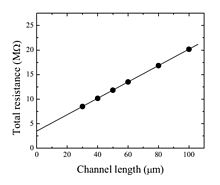Contact resistance
It occurs at electrical connections such as switches, connectors, breakers, contacts, and measurement probes.Contact resistance values are typically small (in the microohm to milliohm range).Contact resistance can cause significant voltage drops and heating in circuits with high current.William Shockley[1] introduced the idea of a potential drop on an injection electrode to explain the difference between experimental results and the model of gradual channel approximation.In two-electrode systems, specific contact resistivity is experimentally defined as the slope of the I–V curve at V = 0: whereInductive and capacitive methods could be used in principle to measure an intrinsic impedance without the complication of contact resistance.The three electrode systems such as transistors require more complicated methods for the contact resistance approximation.The slope of the linear function is related to the channel transconductance and can be used for estimation of the ”contact resistance-free” carrier mobility.[2] Beside the TLM it was proposed the gated four-probe measurement[3] and the modified time-of-flight method (TOF).[7] For given physical and mechanical material properties, parameters that govern the magnitude of electrical contact resistance (ECR) and its variation at an interface relate primarily to surface structure and applied load (Contact mechanics).Quantum point contacts behave more like waveguides than the classical wires of everyday life and may be described by the Landauer scattering formalism.Measurements of thermal conductivity are also subject to contact resistance, with particular significance in heat transport through granular media.Similarly, a drop in hydrostatic pressure (analogous to electrical voltage) occurs when fluid flow transitions from one channel to another.Bad contacts are the cause of failure or poor performance in a wide variety of electrical devices.For example, corroded jumper cable clamps can frustrate attempts to start a vehicle that has a low battery.
electrical connectionsWilliam Shockleyfour-terminal measurementI–V curveohmic contactsInductivecapacitiveimpedancedirect currenttransmission line modeltime-of-flightsurface structureContact mechanicsadsorbedasperitiesmean free pathballistic conductionsurface chemistryFermi wavevectorOhm's lawquantum point contactselementary chargePlanck constantwaveguidesLandauertunnelingsuperconductorsthermal conductivityhydrostatic pressurevoltagefluid flowjumper cablevehiclebatterycorrodedheatingContact cleanerWetting currentShockley, WilliamApplied Physics LettersBibcodeJournal of Applied PhysicsJournal of Physical Chemistry CJournal of Engineering MechanicsPhysical Review BCRC PressTaylor & Francis, Inc.Holm, RagnarHolm, ElseSpringer Science & Business MediaSpringer-Verlag